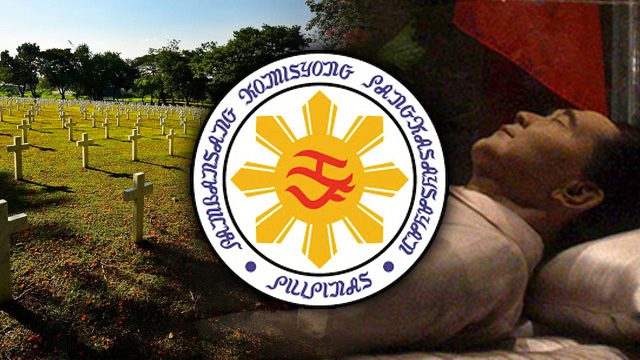SUMMARY
This is AI generated summarization, which may have errors. For context, always refer to the full article.

MANILA, Philippines (UPDATED) – The National Historical Commission of the Philippines (NHCP) is against the burial of former president Ferdinand Marcos at the Libingan ng mga Bayani.
The dictator’s remains are reportedly set to be transferred from Ilocos Norte to the Heroes’ Cemetery on September 18.
The commission said it studied President Rodrigo Duterte’s basis for allowing Marcos’ burial at the cemetery. In May, days after his election victory, Duterte said he would allow it “because he was a Filipino soldier, period.”
This claim supposedly makes Marcos eligible for interment there, in accordance with guidelines set by the Armed Forces of the Philippines (AFP). (READ: Who can be buried at Heroes’ Cemetery? AFP explains rules)
However, in a 26-page pamphlet entitled, “Why Ferdinand E. Marcos Should Not Be Buried at the Libingan ng mga Bayani”, the NHCP disputed Marcos’ record as a soldier during World War II, saying that it is “fraught with myths, factual inconsistencies, and lies.”
The commission said that Marcos “lied about receiving the Distinguished Service Cross, Silver Star, and Order of the Purple Heart”, a claim he supposedly made as early as 1945.
The NHCP earlier said it was the US Medal of Honor that Marcos claimed he received, but the commission on Monday, August 8, clarified it was the Distinguished Service Cross, along with the two other awards.
Marcos’ supposed guerrilla unit, Ang Mga Maharlika, was also “never officially recognized and neither was his leadership of it,” said the NHCP.
US officials, added the NHCP, “did not recognize Mr. Marcos’ rank promotion,” from major in 1944 to lieutenant colonel by 1947.
The former president’s actions as a soldier during WWII were likewise “officially called into question” by the US military.
Along with other sources, the NHCP referred to two documents from the Guerrilla Unit Recognition Files (1942-1948) in the Philippine Archives Collection.
The Ang Mga Maharlika file “contains letters, memoranda, reports, and accounts relating to the guerrilla unit Maj. Marcos claimed to have founded and led.”
Meanwhile, the Allas Intelligence Unit file “pertains to the organization led by Cipriano Allas, which claimed to be the intelligence unit of Ang Mga Maharlika.”
When a historical matter is doubtful, like Marcos’ WWII record, the NHCP wrote in the study’s executive summary that it “may not be established or taken as fact.”
“A doubtful record also does not serve as sound, unassailable basis of historical recognition of any sort, let alone burial in a site intended, as its name suggests, for heroes,” the NHCP added. (READ: Netizens campaign against Marcos burial at Heroes’ Cemetery)
Published on July 12, the pamphlet was the result of NHCP’s study as part of its mandate under Republic Act 10086 “to conduct and disseminate historical research and resolve historical controversies.” – Rappler.com
Add a comment
How does this make you feel?
There are no comments yet. Add your comment to start the conversation.